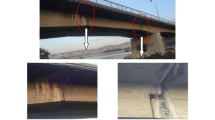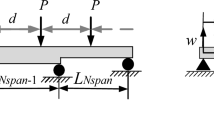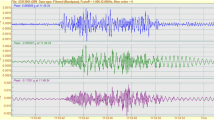Abstract
The aim of this study is to develop a simplified natural fundamental frequency formula for the post-tensioned balanced cantilever bridges using the Operational Modal and Finite Element Analyses results. For this purpose, experimental and numerical studies were carried out on the five post-tensioned balanced cantilever bridges constructed in the city of Artvin, Turkey. First, the experimental and theoretical dynamic characteristics of the selected five bridges were determined using the ambient vibration-based Operational Modal Analysis and Finite Element Method, respectively. Then, the bridge model, which is given the highest correlation between the experimental and theoretical frequencies, was selected to determine the most important parameters that affected the modal behavior of the bridges. The most important parameters were determined as bridge length and pier height. Theoretical modal analyses were carried out for a series of bridge models with different lengths and heights. Finally, a simplified fundamental frequency formula was developed for the post-tensioned balanced cantilever bridges using the method of least squares considering the frequency values obtained from the theoretical modal analyses of the bridge models. The developed formula was checked with the experimentally obtained values, and it was observed that both sets of results were close to each other.







Similar content being viewed by others
References
Altunişik, A. C., Bayraktar, A., Sevim, B., Adanur, S., & Domaniç, A. (2010). Construction stage analysis of Kömürhan highway bridge using time dependent material properties. Structural Engineering and Mechanics, 36(2), 207–223.
Altunışık, A. C., Bayraktar, A., Sevim, B., & Ateş, Ş. (2011). Ambient vibration based seismic evaluation of isolated Gülburnu Highway Bridge. Soil Dynamics and Earthquake Engineering, 31(11), 1496–1510.
Ates, Ş. (2011). Numerical modelling of continuous concrete box girder bridges considering construction stages. Applied Mathematical Modelling, 35(8), 3809–3820.
Ates, S., Atmaca, B., Yildirim, E., & Demiroz, N. A. (2013). Effects of soil-structure interaction on construction stage analysis of highway bridges. Computers and Concrete, 12(2), 169–186.
Bayraktar, A., Altuşnişık, A. C., Sevim, B., Domaniç, A., & Taş, Y. (2009). Vibration characteristics of Kömürhan highway bridge constructed with balanced cantilever method. Journal of Performance of Constructed Facilities, 23(2), 90–99.
Bridge Projects (2007). General Directorate of State Hydraulic Works, Ankara, Turkey.
Casas, J. R. (1997). Reliability-based partial safety factors in cantilever construction of concrete bridges. Journal of Structural Engineering, 123(3), 305–312.
Chen, X., Omenzetter, P., & Beskhyroun, S. (2013). Dynamic testing and long term monitoring of a twelve span viaduct. Key Engineering Materials, 569–570, 342–349.
Gentile, C., & Bernardini, G. (2008). Output-only modal identification of a reinforced concrete bridge from radar-based measurements. Nondestructive Testing and Evaluation, 41, 544–553.
Hedjazi, S., Rahai, A., & Sennah, K. (2007). Evaluation of creep effects on the time-dependent deflections and stresses in prestressed concrete bridges. Bridge Structures, 3(2), 119–132.
Hewson, N. (2007). Balanced cantilever bridges. Concrete (London), 41(10), 59–60.
Jung, S., Ghaboussi, J., & Marulanda, C. (2007). Field calibration of time-dependent behavior in segmental bridges using self-learning simulation. Engineering Structures, 29(10), 2692–2700.
Kamaitis, Z. (2008). Field investigation of joints in precast post-tensioned segmental concrete bridges. Baltic Journal of Road and Bridge Engineering, 3(4), 198–205.
Kronenberg, J. (2008). Continous concrete placing during balanced cantilever construction of a bridge. Concrete Engineering International, 12(3), 38–39.
Kudu, F. N., Bayraktar, A., Bakir, P. G., Türker, T., & Altunişik, A. C. (2014). Ambient vibration testing of Berta Highway Bridge with post-tension tendons. Steel and Composite Structures, 16(1), 23–46.
Kwak, H.-G., & Son, J.-K. (2004a). Span ratios in bridges constructed using a balanced cantilever method. Construction and Building Materials, 18(10), 767–779.
Kwak, H.-G., & Son, J.-K. (2004b). Design moment variations in bridges constructed using a balanced cantilever method. Construction and Building Materials, 18(10), 753–766.
Liu, C., DeWolf, J. T., & Kim, J. (2009). Development of a baseline for structural health monitoring for a curved post-tensioned concrete box girder bridge. Engineering Structures, 31, 3107–3115.
Malm, R., & Sundquist, H. (2010). Time-dependent analyses of segmentally constructed balanced cantilever bridges. Engineering Structures, 32(4), 1038–1045.
Manjure, P. Y. (2001). Rehabilitation of balanced cantilever bridges. Indian Concrete Journal, 75(1), 76–82.
Marzouk, M., Said, H., & El-Said, M. (2008). Special-purpose simulation model for balanced cantilever bridges. Journal of Bridge Engineering, 13(2), 122–131.
McDonald, B., Saraf, V., & Ross, B. (2003). A spectacular collapse: Koror-Babeldaob (Palau) balanced cantilever prestressed, post-tensioned bridge. Indian Concrete Journal, 77(3), 955–962.
Morassi, A., & Tonon, S. (2008). Dynamic testing for structural identification of a bridge. Journal of Bridge Engineering, 13, 573–585.
OMA. (2006). Operational modal analysis, release 4.0. Denmark: Structural Vibration Solution A/S.
Pimanmas, A. (2007). The effect of long-term creep and prestressing on moment redistribution of balanced cantilever cast-in-place segmental bridge. Songklanakarin Journal of Science and Technology, 29(1), 205–216.
Pimanmas, A., Imsombat, S., & Neilsen, K. Hj. (2009). New Phra-Nangklao bridge—A balanced cantilever prestressed concrete bridge in Thailand. Structural Engineering International, 19(1), 38–40.
Pimentel, M., & Figueiras, J. (2017). Assessment of an existing fully prestressed box-girder bridge, Proceedings of the Institution of Civil Engineers. Bridge Engineering, 170(1), 42–53.
PULSE. (2006). Analyzers and solutions, release 11.2. Denmark: Bruel and Kjaer.
SAP2000. (2010). Structural analyses program. California, USA: Computers and Structures Inc.
Schmidt, S., & Solari, G. (2003). 3-D wind-induced effects on bridges during balanced cantilever erection stages. Wind and Structures, An International Journal, 6(1), 1–22.
Skrinar, M., & Strukelj, A. (1996). Eigen frequency monitoring during bridge erection. Structural Engineering International, 6(3), 191–194.
Starossek, U. (2009). Shin Chon Bridge Korea. Structural Engineering International, 19(1), 79–84.
Stathopoulos, S., Seifried, G., Kotsanopoulos, P., Haug, H., Spyropoulos, I., & Stathopoulos, K. (2010). The Metsovo bridge, Greece. Structural Engineering International, 20(1), 49–53.
Strommen, E., Hjorth-Hansen, E., & Kaspersen, J. H. (2001). Dynamic loading effects of a rectangular box girder bridge. Journal of Wind Engineering and Industrial Aerodynamics, 89(14–15), 1607–1618.
Sümerkan, S. (2014). Natural frequency formula post tensioned balanced cantilever bridges. MSC Thesis, Karadeniz Technical University, Trabzon, Türkiye (in Turkish).
Turan, F. N. (2012). Determination of dynamic characteristics of balanced cantilever reinforced concrete bridges using ambient vibration data. MSc Thesis, Karadeniz Technical University, Trabzon, Türkiye (in Turkish).
Vonganan, B. (2009). The second Mekong international bridge, Thailand. Structural Engineering International, 19(1), 67–68.
Acknowledgements
The authors would like to express their gratitude to the General Directorate of State Hydraulic Works, DOLSAR Engineering Co. Ltd., PÖYRY Infra Limited, Sümerkan Engineering, and Assist. Prof. Dr. Hasan Basri BAŞAĞA for their contributions to this study.
Author information
Authors and Affiliations
Corresponding author
Ethics declarations
Conflict of interest
On behalf of all authors, the corresponding author states that there is no conflict of interest.
Additional information
Publisher's Note
Springer Nature remains neutral with regard to jurisdictional claims in published maps and institutional affiliations.
Rights and permissions
About this article
Cite this article
Sümerkan, S., Bayraktar, A., Türker, T. et al. A simplified frequency formula for post-tensioned balanced cantilever bridges. Asian J Civ Eng 20, 983–997 (2019). https://doi.org/10.1007/s42107-019-00160-y
Received:
Accepted:
Published:
Issue Date:
DOI: https://doi.org/10.1007/s42107-019-00160-y




